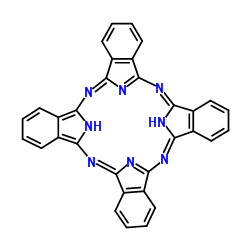PHTHALOCYANINE

PHTHALOCYANINE structure
|
Common Name | PHTHALOCYANINE | ||
|---|---|---|---|---|
| CAS Number | 574-93-6 | Molecular Weight | 514.539 | |
| Density | 1.5±0.1 g/cm3 | Boiling Point | 590.15°C (rough estimate) | |
| Molecular Formula | C32H18N8 | Melting Point | >300ºC (dec.)(lit.) | |
| MSDS | USA | Flash Point | N/A | |
|
Temperature-controlled self-assembling structure with selective guest-recognition at the liquid-solid interface.
Phys. Chem. Chem. Phys. 15(1) , 125-8, (2013) We investigate the influence of temperature on the self-assembly of 2,6,11-tricarboxydecyloxy-3,7,10-triundecyloxy triphenylene (asym-TTT) adsorbed on HOPG using scanning tunneling microscopy (STM) at the liquid/solid interface. We show that the packing struc... |
|
|
Oncologic photodynamic diagnosis and therapy: confocal Raman/fluorescence imaging of metal phthalocyanines in human breast cancer tissue in vitro.
Analyst 139(21) , 5547-59, (2014) Raman microspectroscopy and confocal Raman imaging combined with confocal fluorescence were used to study the distribution and aggregation of aluminum tetrasulfonated phthalocyanine (AlPcS4) in noncancerous and cancerous breast tissues. The results demonstrat... |
|
|
Photoimmunotherapy lowers recurrence after pancreatic cancer surgery in orthotopic nude mouse models.
J. Surg. Res. 197 , 5-11, (2015) Photoimmunotherapy (PIT) is based on the use of a monoclonal antibody specific to cancer epitopes conjugated to a photosensitizer near-infrared phthalocyanine dye (IR700). In this study, PIT with IR700 conjugated to anti-carcinoembryonic antigen (CEA) was use... |
|
|
Near infra-red photoimmunotherapy with anti-CEA-IR700 results in extensive tumor lysis and a significant decrease in tumor burden in orthotopic mouse models of pancreatic cancer.
PLoS ONE 10(3) , e0121989, (2015) Photoimmunotherapy (PIT) of cancer utilizes tumor-specific monoclonal antibodies conjugated to a photosensitizer phthalocyanine dye IR700 which becomes cytotoxic upon irradiation with near infrared light. In this study, we aimed to evaluate the efficacy of PI... |
|
|
Synthesis of novel octa-cationic and non-ionic 1,2-ethanediamine substituted zinc (Ⅱ) phthalocyanines and their in vitro anti-cancer activity comparison.
Eur. J. Med. Chem. 58 , 12-21, (2012) Novel tetra-substituted zinc phthalocyanines (Pcs) bearing 1,2-ethanediamine group and the quaternized derivatives were synthesized and characterized. The photophysical and cellular properties of these Pcs were investigated. The results indicated that the qua... |
|
|
Noncovalent binding of xanthene and phthalocyanine dyes with graphene sheets: the effect of the molecular structure revealed by a photophysical study.
Spectrochim. Acta. A. Mol. Biomol. Spectrosc. 113 , 92-9, (2013) The fluorescence and absorption properties of several xanthene and phthalocyanine dyes were measured in the presence and absence of chemically derived graphene (CDG) sheets. The interaction of pyronine Y (PYY) with graphene sheets was compared with that of rh... |
|
|
Decorating single layer graphene oxide with electron donor and acceptor molecules for the study of photoinduced electron transfer.
Chem. Commun. (Camb.) 49(20) , 2013-5, (2013) Graphene oxide decorated with an electron donor, zinc(II) phthalocyanine, and an electron acceptor, fullerene, has been synthesized, and photoinduced electron transfer leading to charge-separation is reported. |
|
|
A Mild Catalytic Oxidation System: FePcOTf/H2O2 Applied for Cyclohexene Dihydroxylation.
Molecules 20 , 8429-39, (2015) Iron (III) phthalocyanine complexes were employed for the first time as a mild and efficient Lewis acid catalyst in the selective oxidation of cyclohexene to cyclohexane-1,2-diol. It was found that the catalyst FePcOTf shown excellent conversion and moderate ... |
|
|
Experimental and computational studies on 4-[(3,5-dimethyl-1H-pyrazol-1-yl)methoxy]phthalonitrile and synthesis and spectroscopic characterization of its novel phthalocyanine magnesium(II) and tin(II) metal complexes.
Spectrochim. Acta. A. Mol. Biomol. Spectrosc. 114 , 531-40, (2013) The molecular structure of the substituted phthalonitrile was analyzed crystallographically and compared with optimized geometric structure. The structural properties of the compound such as energy, vibrational frequency, ground state transitions, (1)H and (1... |
|
|
Near-infrared sensitization in dye-sensitized solar cells.
Chimia 67(3) , 129-35, (2013) Dye-sensitized solar cells (DSCs) are a low cost and colorful promising alternative to standard silicon photovoltaic cells. Though many of the highest efficiencies have been associated with sensitizers absorbing only in the visible portion of the solar radiat... |